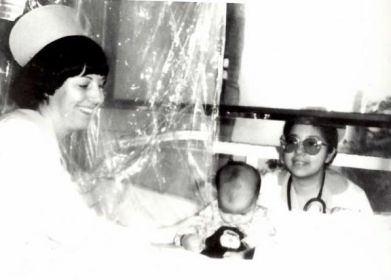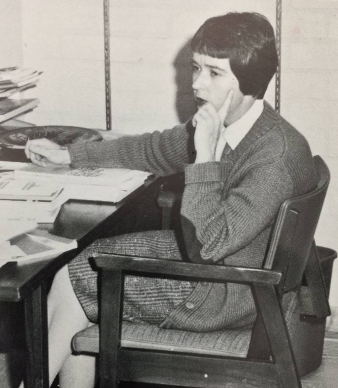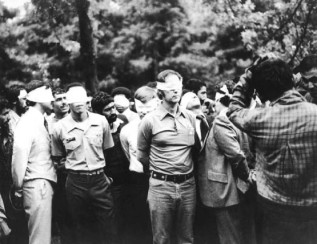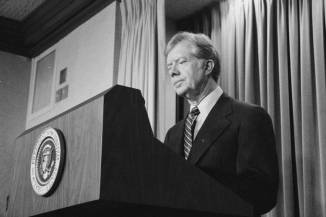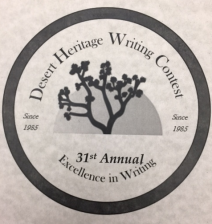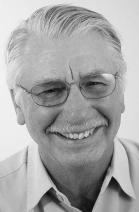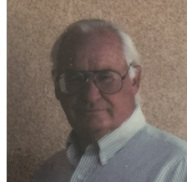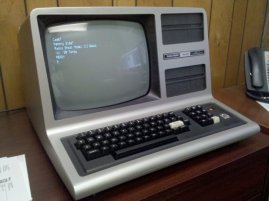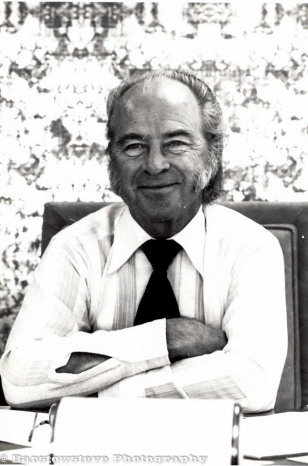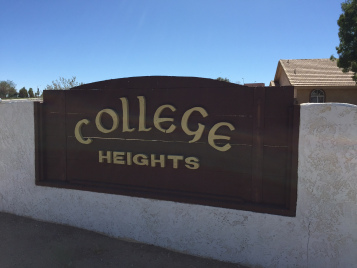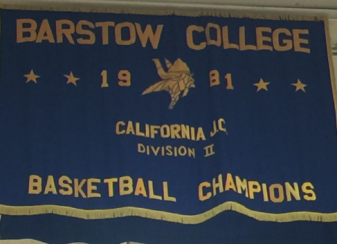The 1980s
The decade of the 1980s was a time of turbulence and transformation at Barstow Community College. California’s financial stresses put pressure on all state colleges and universities. The college board was forced to make hard decisions and develop creative ways to ensure the school’s survival. International affairs, like the aftermath of the Iranian Hostage Crisis and President Carter’s reaction to it, affected BCC’s foreign students. A faculty member suddenly died on campus. Despite tight budgets, important building renovations occurred and centers were rededicated.
Against all obstacles, student enrollment grew and high academic and professional standards prevailed. The nursing program blossomed. The college achieved Basketball Hall of Fame status and the school continued its role as a key regional intellectual, career training, and economic center.
by Steve Smith
-
My first classes were in the early Eighties. My mom, Nancy Smith, was a student and a worker at the college at the time. The high school had a policy of giving students units for a college student so I went to some of her classes. One of the classes I went to was an economics class and one of the students was Mayor Barney Keller. He was going to the class to help him learn about the principles that were used in city management.
-
One summer, the college had a new program that had high school students take a number of classes at the college to get them ready for after graduation. One of the teachers I had was former college President Don White. He taught personal psychology. I remember the fun advice in his lectures. One pertinent piece of advice was to never order fried chicken at a restaurant because it was better to stick with a chicken place, like KFC, that knew what they were doing with chicken. I liked his class so much. I was looking forward to taking more classes with him but about a month after our class, he passed away from cancer.
-
Professor Norm Rowan and my Mother brought the computer lab into modern times. When she started to take computer classes, the only computer at the time was a machine as big as a table with no monitor. You had to blindly type in a program in machine code and the results would print out on paper. If it didn’t come out right you had to type in the program over again.
-
When Mr. Rowan and my Mom tried to get new computers the college board at the time didn’t see the need for them. There were many meetings and discussions to finally get a number of great old Radio Shack TRS 80s.
-
In the early day of computers, the machines could be humorously flaky. One day, Dr. Baca took some officials to show them our lab. One of the color monitors was actually black and white. I was working at the lab at the time and Dr. Baca asked me why the monitor wasn’t in color. I knew what the problem was. I bonked the top of the monitor lightly with my fist. The color then slowly dripped down from the top to the bottom. Baca then gave me a great look of disbelief.
-
One of my friends that hung out at the lab was a guy named Vincent. Besides hanging out at the lab we also ran a small business. It was a continuing problem at the time for students' papers to get damaged through basically carrying them around on discs. We would charge students five dollars to repair the files. We were very good and we never completely lost a paper.
- One of my favorite computer science teachers was Lannon Stafford. He was an extremely knowledgeable Texas gentleman. In his actions and words, his focus was always on the students. One day, he taught a class and went back to my mom’s office and sat down in a chair. He told my mom he wasn’t feeling well. He slumped over, the paramedics were called and sadly, he didn’t make it.
-
At the time there were some other great characters working at the college. One of them was Carolyn Tabor, she was a counselor and the only one I would see for help. One time her cat disappeared and she put out notices all over the campus to find it. After a time the cat came back. I asked about the cat and she told me, “He came back but he refuses to tell me where we went.”
-
Another great teacher was John Stacy. I had him for creative writing a number of times. One time we had a classroom in Mercado Mall downtown. One of those times we didn’t have enough people registered for the class to meet. Mr. Stacy had the class anyway and opened the doors and didn’t get paid for his time.
Student Life
In the 1970s, Barstow Community College welcomed many international students. Matriculation at Barstow College introduced these students to American higher education. And international student tuition assisted the school with badly needed revenues. Stormy international affairs impacted students from Iran in the late 1970s and by the early 1980s, there were no Iranian nationals studying at the college.
The Iranian Hostage Crisis and Barstow Community College
On November 4, 1979, 52 American diplomats were taken hostage after a mob stormed the American embassy in Tehran. They were held captive in Persia for 444 days before being released. President Jimmy Carter called the hostages “victims of terrorism and anarchy.” The thugs who stormed the embassy were Iranian students who supported the return of theocratic leader Ayatollah Khomeini and the imposition of religious rule in Iran. The Shah had been deposed and fled to the United States for cancer treatment. Many Iranians were outraged that the United States granted Shah Mohammed Reza Pahlavi asylum. So, they attacked American diplomats. Ultimately, after one failed American rescue attempt and with the help of Canadian diplomats, the hostages were freed. Bitterness and suspicion from these days persist.
The hostage crisis was only part of a long and bitter struggle between the United States and her ally Great Britain and the democratic government in Iran. In 1953, the democratically elected Prime Minister of Iran, Mohammed Mosaddegh, was deposed in a coup d’etat engineered by the American CIA, the British MI-6, and British Petroleum. This ended a power struggle between Mosaddegh and Pahlavi. The Shah made himself the absolute ruler of Iran and took steps to modernize and secularize the country. He used his brutal Secret Police called SAAVAK, to impose his will. Concern for Iranian oil resources ensured the United States and British support of the Shah. But the brutality of the Pahlavi regime angered most Iranians. They turned to exiled mullah Khomeini to lead a revolution that toppled the monarchy. Many of the Iranian students who came to Barstow were from families who supported the Shah. Others were not.
“It’s so dumb, what is happening,” Iranian student Dezael, 25, explained. “The Shah is not important. Not important enough to cut 65 people.” Other Iranian students said they were concerned about affairs in their home country. “At first, I supported Khomeini,” another student said. “But now no one knows what he is doing. We need another revolution, not a religious one.” (Desert Dispatch, Nov. 10, 1979)
Faculty and administrators at the college said the Iranian students were trying to keep a low profile during the crisis. “If there’s anything political going on, it’s probably moved underground,” Foreign Student Director Barbara Hankerson said. “Most of the vocal people have left.”
Despite Iranian students' attempts to quietly pursue their studies, on November 15, 1979, a gang of American thugs from off-campus, not BCC students, attacked four Iranian students. No one was seriously hurt, but the campus was closed for the rest of the day and into the evening. “These Iranian students were attacked by non-student bigots who came to campus to cause trouble. Without any provocation, they jumped the… students,” President Edwin Spear explained. “These were not our own students and no one was hurt.” (Dispatch, Nov. 16, 1979.
The Federal Immigration Service and the FBI met with BCC’s Iranian students and verified their visas and status. “Everyone was cleared”, Spear said.
Despite the goodwill of the college, by the end of 1980, all Iranian national students were gone from campus. President Jimmy Carter ordered the revocation of all Iranian student visas. “We are spending our money here”, student Mortera Sectaries explained. “Somebody has to help this school. I think this is all done for his re-election. I don’t think it will be effective.” (Dispatch, March 18, 1980)
Student Khalilah explained that the Shah was bad, but he was uncertain about the Revolution. “The Shah sold us for 50 years. We need freedom, too. And now we’re fighting for it.” (Dispatch, March 18, 1980)
Aftermath
After the drama of the hostage crisis, the college board took to discuss a proposal limiting foreign students to 30 from every country.
The college board reviewed the status of Iranian and all foreign students and decided that all Barstow students should be treated fairly and equally. In past years, international students were required to purchase student insurance. The board decided to drop that requirement, as other students were not required to have it.
“During the …past year, the problems with Iran have increased awareness of the legal rights of different aliens,” President Edwin Spear explained. He added that all people have protection under the 14th Amendment to the United States Constitution.
The 1980s: The Desert Heritage Writing Contest
A major highlight of the 1980s was the founding of the Desert Heritage Writing Contest at Barstow Community College. The contest originated in the 1970s as part of enrichment programs for San Bernardino County Middle and High Schools. By 1985, the competition expanded to include the college.
“Barstow was to celebrate its Centennial in 1986”, High School teacher Cliff Walker explained. “I got together with other teachers and college instructors and college President Ed Spear and we all agreed inclusion of college writers would be a good thing. It was a way to honor the town’s 100th year.”
Walker also explained that he and others felt that it was good to recognize athletes and sports, but fine writing should be honored and encouraged as well.
Walker, who also taught some college classes explained that “It was President Ed Spear who was instrumental in pushing for approval through the faculty committee. He did a great job and was really supportive.”
Walker explained that there were four components to the contest. “We had Impromptu, Poetry, Fiction, and Non-Fiction,” Walker said. “Now, each teacher was supposed to choose the best five entries from each component. But on the lower levels, a lot of the middle and high school teachers just submitted every entry. Believe me, a lot of the college judges go tired of reading impromptu essays about “My Favorite Animal,” by fifth and sixth graders. So, eventually, the Impromptu competition was eliminated.”
Steve Smith, a former BCC student, and local historian were one of the early contest winners. “I think it did a lot for the community and I know it encouraged me in writing,” Smith said.
Prizes for contest winners included books, pens, and cash.” It makes me happy to see so many students achieving recognition,” Walker said. ”Some of the winners went on to become journalists, authors, and attorneys.”
Among the original college contest founders and judges were instructors Richard Reeb, Silver Valley High School teacher Mary McCarthy and instructor R. Chamberlain.
In 2015, the Desert Heritage Writing Contest celebrated 30 years of accomplished young writers. At the time of this writing, the contest celebrates 31 years of High Desert writing.
Remembering the 1980’s: Cliff Walker
Founder of the Desert Heritage Writing Contest, Cliff Walker was involved with Barstow Community College from its inception. A high school teacher, Walker also taught part-time at the college. This was typical of most community colleges. As time passed and school budgets tightened, adjunct faculty assumed the bulk of the teaching load on many campuses.
“We started out teaching classes at the local high school and some churches,” Walker recalled. “The campus has expanded so much and we were proud to introduce the writing contest in the 1980s. We called it a heritage contest because we founded it the official anniversary year of the founding of Barstow.”
Walker said the campus was much busier in the 1980s, as classes were held Monday through Friday and there were lots of student and social activities, as well as thriving community enrichment classes. “Today, when I go up to campus on Fridays, it is almost empty. The campus is completely closed on weekends, even the library,” Walker said. “We used to offer so many wonderful enrichment classes–human history of the Mojave Desert, docent training for the community at local museums. All of that is gone now.”
Walker said he was not sure why the college did away with community enrichment programs, but they were now gone. Walker explained that since the Great Recession, finances supporting programs were decreased. “The campus was such a busy place in the 1980s. Students and classes, our championship sports teams, community members, and their involvement. Things have changed.”
Walker explained that computers have transformed the teaching and learning process. “Now, many students just work from home in online classes. This may account for the increasing emptiness on campus. We still have both day and evening classes on the grounds and at Ft. Irwin, but there are no crowds of students all the time. The learning is still there, but there does not seem to be much campus life anymore.”
Walker said in spite of everything, Barstow Community College is a school for students, faculty, and the community to support and admire. “We have done so much,” Walker concluded.
Death comes to campus
A tragic incident occurred on campus in the 1980s. Popular computer science instructor Lannon Stafford, exhausted after a day of teaching, went to visit fellow computer science colleague Nancy Smith.
“He went into the office to see my mother,” fellow computer enthusiast and BCC student Steve Smith explained.
“He sat down and said he felt tired and didn’t feel well. Then, he passed out. EMTs were called. But it was too late. He was gone.”
The medical consensus was a heart attack. “Mr. Stafford was one of my favorites,” Smith explained. “He was a true Texas gentleman. He was tall and always focused on his students. It was a shock and an unexpected loss.”
Renovation and Rededication of Norman Smith Center
After careful budgeting and months of renovation, the Norman Smith Center opened “just ahead of schedule,” college President J.W. Spear explained. The remodeling of the student center cost $283,500. The center reopened with a rededication in August 1980.
In honor of the renovated center, Barstow drama students presented a two-act comedy, about a college chemist making moonshine. “This is a difficult play to produce”, Master Thespian Drama professor Dr. Bill Pullen said. “But we are pleased to entertain in honor of the new center.” (Dispatch, Aug. 4, 1980)
Faculty and Administration at odds over wages
Early in the 1980s, faculty, administration, and college board clashed over salary increases. The salary stalemate was reported in a series by the Desert Dispatch.
Outside mediators were retained to try and break the deadlock, but tensions persisted for weeks.
“The talks are…stalemated,” College head Dr. Edwin Spear explained. “No real progress was made.” (Dispatch, Aug. 6, 1980) Faculty Association President Bill Pullen refused to comment on the situation.
Deadlocked negotiations over salaries, grievance procedures, and workloads dragged on for six months. Finally, in December, a mutually acceptable agreement was reached.
“The new contract brings the base salary for a first-year instructor to $17, 481” according to Dispatch reports. “The annual salary for an instructor with 12 or more years of experience…will be $31, 255.”
Military and Veterans Issues
Supporting military education continued as a major part of Barstow College’s mission in the 1980s. Many military students attended classes and continued graduating with high honors. However, the college board received a shock in November of 1980 when they received a bill from the federal Veteran’s Administration for $230,000.
The VA maintained that Barstow and nine other colleges accepted funds for military students and did not use all the funds and hence owed the VA some $15 million in reimbursement. The alleged Barstow College portion was $230,000. With the opening of the remodeled Student Center, college funds had been set aside for new furniture. That funding was threatened by the announced shortfall.
College President Spear explained that before any action could be taken by the VA or the college, the Department of Justice would investigate the claim. Spear explained that, according to BCC’s contract with the VA, “there was no clause, stipulating that any excess monies be returned to the VA.” Spear maintained that the school was offered a “flat fee” for veterans’ education and that the college accepted it. The matter would be investigated and decided by the federal system. Meanwhile, the college turned to other resources to furnish the new student center.
College Heights
With state and county money cut the college found a way to hang on. Barstow College sold the land that would become College Heights. Thus saving Barstow Community College from going under.
1980s Accomplishments
Maintaining a lively and growing campus was a key achievement for Barstow Community College in the 1980s. The college faced increasing financial stress and the board developed solutions to keep the school alive and growing. Among these solutions was the selling of some college land for the College Heights housing development.
Other proud accomplishments included Barstow Community College’s entry into the Basketball Hall of Fame and outstanding success in college football. Outstanding college coaches Dale Fries and his football team and Jim Parks, who led the basketball team to the Basketball Hall of Fame were instrumental leaders. On March 12, 2010, Coach Jim Parks was inducted into the California Community College Coaches Association Men’s Basketball Hall of Fame.
Both Coaches Fries and Parks were honored for their skills on the college campus in the Fall of 2016.

